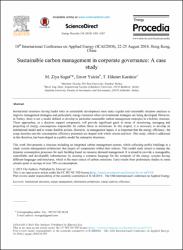| dc.contributor.author | Söğüt, M. Ziya | |
| dc.contributor.author | Yalçın, Enver | |
| dc.contributor.author | Karakoç, T. Hikmet | |
| dc.date.accessioned | 2021-06-05T19:56:32Z | |
| dc.date.available | 2021-06-05T19:56:32Z | |
| dc.date.issued | 2019 | |
| dc.identifier.issn | 1876-6102 | |
| dc.identifier.uri | https://doi.org/10.1016/j.egypro.2019.01.978 | |
| dc.identifier.uri | https://hdl.handle.net/20.500.12960/298 | |
| dc.description | 0000-0002-9782-7885 | en_US |
| dc.description | 0000-0001-8182-8667 | en_US |
| dc.description | 0000-0002-9782-7885 | en_US |
| dc.description | 0000-0001-6171-1955 | en_US |
| dc.description | WOS:000471031703104 | en_US |
| dc.description.abstract | Institutional structures having leader roles in sustainable development must make regular and sustainable situation analyses to improve management strategies and particularly energy resources when environmental strategies are being developed. However, in Turkey, there is not a model defined to develop in particular sustainable carbon management strategies in a holistic structure. These approaches, as a decision support component, will provide significant gains in terms of monitoring, managing and projecting of energy consumptions responsible for carbon threat in institutions. In this respect, it is necessary to develop an institutional model and to create feasible actions. However, in management inputs, it is important that the energy efficiency, the usage densities and the consumption efficiency potentials are shaped with which criteria and how. This study, which is addressed in this direction, has been shaped as a public model for enterprise structures. This work first presents a structure including an integrated carbon management system, which collecting public buildings in a single system management architecture that targets all components within their context. This model study aimed to manage the dynamic consumption processes for each building based on resource demand management. It is aimed to provide a manageable, controllable and developable infrastructure by creating a common language for the terminals of the energy systems having different languages and structures, which is the main source of carbon emissions. Early results from preliminary studies in some schools point to savings of over 20% in consumption. (C) 2019 The Authors. Published by Elsevier Ltd. | en_US |
| dc.description.sponsorship | Appl Energy Innovat Inst, Malardalen Univ, Future Energy Ctr, Elsevier, Solar Energy Soc Hong Kong, CSEE Journal Power & Energy Syst, UNiLAB | en_US |
| dc.language.iso | eng | en_US |
| dc.publisher | Elsevier Science Bv | en_US |
| dc.relation.ispartof | Innovative Solutions for Energy Transitions | en_US |
| dc.relation.ispartof | 10th International Conference on Applied Energy (ICAE) -- AUG 22-25, 2018 -- Hong Kong, HONG KONG | en_US |
| dc.relation.ispartofseries | Energy Procedia | |
| dc.rights | info:eu-repo/semantics/openAccess | en_US |
| dc.subject | Institutional Structures | en_US |
| dc.subject | Energy Management | en_US |
| dc.subject | İnformation Architecture | en_US |
| dc.subject | Energy Analysis | en_US |
| dc.subject | Efficiency | en_US |
| dc.title | Sustainable carbon management in corporate governance: A case study | en_US |
| dc.type | conferenceObject | en_US |
| dc.department | İktisadi ve İdari Bilimler Fakültesi, Denizcilik İşletmeleri Yönetimi Bölümü | en_US |
| dc.department-temp | [Sogut, M. Ziya] Piri Reis Univ, Maritime Fac, Istanbul, Turkey; [Yalcin, Enver] Balikesir Univ, Mech Eng Dept, Engn Fac, TR-10145 Balikesir, Turkey; [Karakoc, T. Hikmet] Anadolu Univ, Fac Aeronaut & Astronaut, TR-26470 Eskisehir, Turkey | en_US |
| dc.contributor.institutionauthor | Söğüt, M. Ziya | |
| dc.identifier.doi | 10.1016/j.egypro.2019.01.978 | |
| dc.identifier.volume | 158 | en_US |
| dc.identifier.startpage | 3302 | en_US |
| dc.identifier.endpage | 3307 | en_US |
| dc.relation.publicationcategory | Konferans Öğesi - Uluslararası - Kurum Öğretim Elemanı | en_US |

















